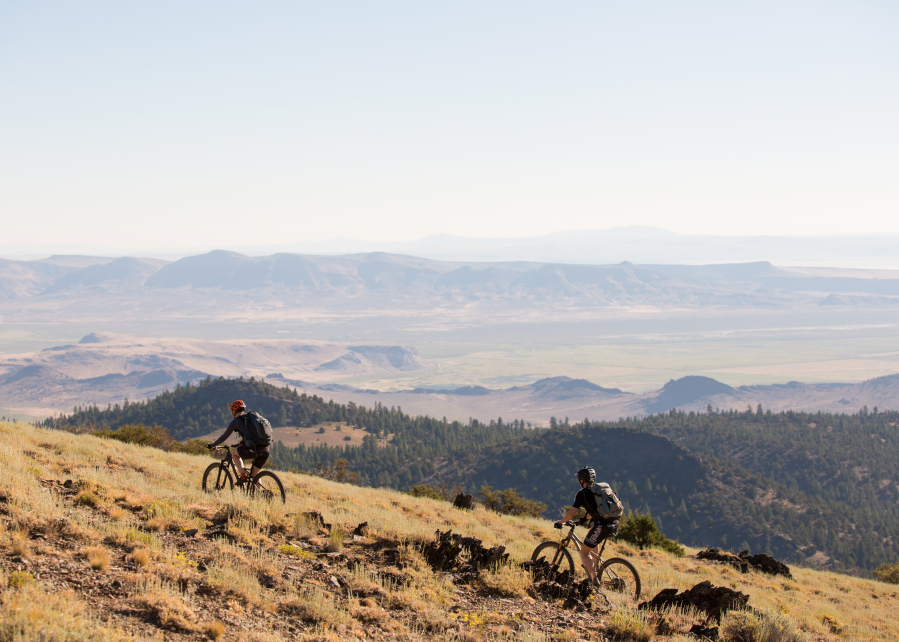BEND, Ore — Oregon is teeming with adventure-seeking cyclists, so the idea of biking across the state is not a new one.
But the idea of off-road biking across the state on a route that is more than half singletrack is a new one.
It is called the Oregon Timber Trail, and it has some mountain bikers and long-distance bikepackers giddy with excitement at the prospect of attempting part of the 670-mile route from south of Lakeview north to Hood River, or all of it.
The route is entirely pre-existing trails or roads and is made up of about 50 percent singletrack, 40 percent dirt roads and 10 percent pavement, according to project manager Gabriel Tiller. The trail is organized into four tiers from south to north: the Fremont Tier, Willamette Tier, Deschutes Tier and Hood Tier. The route, which includes 66,000 feet of elevation gain, carefully avoids wilderness areas and other trails on which bikes are not permitted.
“These are all areas that we should have been exploring and riding our bikes, but we haven’t had a catalyst yet,” says Bend’s Adam Craig. “Now we have that.”
Craig, a former Olympic and pro mountain biker, was part of a recent trail stewardship outing that cleared miles and miles of downed trees on the Fremont Tier. He says it is likely that he will eventually become the Deschutes Tier stewardship coordinator, organizing trail work on that stretch of the OTT.
The Deschutes Tier cuts through Central Oregon on some familiar and perhaps not-so-familiar trails and roads, passing by several Cascade lakes, Mount Bachelor, Tam McArthur Rim, the communities of Sisters and Camp Sherman, and the old Santiam Wagon Road.
The OTT is a partnership among Travel Oregon, the U.S. Forest Service and the Portland-based expedition company Limberlost, founded by Tiller.
The idea started with Travel Oregon, the state’s tourism commission, which hired trail planning expert Chris Bernhardt in 2015 to create the route alignment and concept. Bernhardt brought on Tiller to help perfect the route and organize trail work.
Tiller and Harry Dalgaard, a tourism program manager with Travel Oregon, spent nearly a year meeting with more than 40 trail-user groups and working closely with the Forest Service and the Bureau of Land Management to make the OTT a reality.
“When I got involved it was a rough list of trails that might connect somehow,” Tiller says, “I sort of dug deeper, mapped all those connections out, and figured out what other trails we needed on there. We wanted to figure out this alignment, create the route, and sort of build that momentum of users and potential users in the state and across the country.”
The OTT was inspired by the 2,650-mile Pacific Crest Trail, which is not open to bikes, and other long-distance trails on which cycling is allowed, such as the 800-mile Arizona Trail and the 2,800-mile Great Divide mountain bike route that cuts through the Rocky Mountains from Canada to Mexico.
“This is the first one to really be developed with the focus on mountain biking and backcountry mountain biking,” Tiller says. “But this is going to be open to all (nonmotorized) uses. Equestrians and hikers can use the trail, too.”
While a general map and more information currently can be found at oregontimbertrail.org, the route guide and detailed maps have yet to be released, as they are still being reviewed.
“The route guide is written and pretty much signed off on, but we’re just waiting to get a thumbs up from all the different groups,” Tiller says. “There’s a lot of stakeholders involved in the whole process.”
Tiller adds that the goal is to have the detailed maps and route guide online by the end of the month, so those who want to ride the trail this year can start by mid-July.
The OTT is being introduced just as bikepacking is increasing in popularity. Bikepacking involves cycling over long distances and over an extended period of time while camping each night. The estimated time to complete the entire OTT for a bikepacker is 20 to 30 days.
Another popular bikepacking route in Oregon is the 364-mile Oregon Outback, a route of mostly gravel roads that cuts through the High Desert from Klamath Falls to the confluence of the Deschutes and Columbia rivers.
“It’s sort of a burgeoning sport,” Tiller says of bikepacking. “People have been camping with their bikes for a long time, but for whatever reason it’s sort of real hot right now, this bikepacking trend. I expect it to continue to be popular, because it’s gotten a lot easier recently, just with a lot of changes in gear technology. You’re able to pack lighter and camp more comfortably. It really opens up a lot of doors. To me, it’s unique when compared to hiking or backpacking, in that you can cover a lot more distance a lot quicker, and end up seeing a lot more diversity of landscape.”



